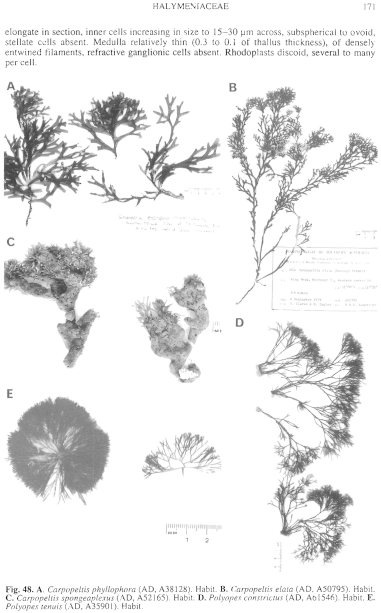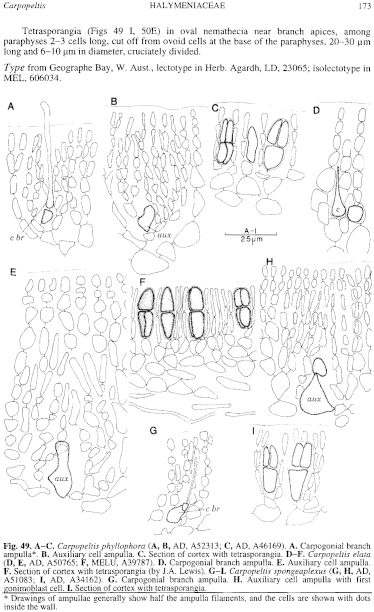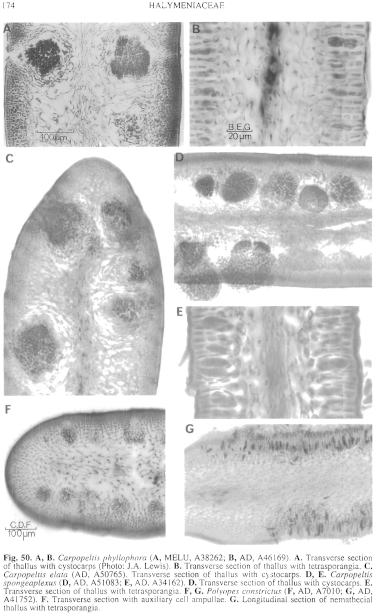|
|
|
|
|
|||||||||||
|
Electronic Flora of South Australia Species Fact Sheet
Phylum Rhodophyta – Class Florideophyceae – Order Gigartinales – Family Halymeniaceae
Selected citations: Chiang 1970: 66, fig. 32, pl. 9b. De Toni 1905: 1604. Schmitz & Hauptfleisch 1897: 514.
Synonyms
Acropeltis phyllophora Hooker & Harvey 1847: 407. Harvey 1863: pl. 283. Kützing 1869: 13, pl. 35a, b.
Rhodymenia (Acropeltis) phyllophora Harvey 1855a: 554; 1859b: 319.
Cryptonemia phyllophora (Hooker & Harvey) J. Agardh 1876: 163.
Thallus (Fig. 48A) dark red-brown, cartilaginous, 4–25 cm high, complanately and alternately branched, upper branches 2–4 mm broad in small forms, 3–5 mm broad in robust forms, 80–120 µm thick above, 150–200 µm thick below, apices broad and rounded, axils usually rounded, becoming denuded below with a thickened midrib. Holdfast discoid, 1–5 mm across; epilithic. Structure (Fig. 50A) of a pseudoparenchymatous cortex 4–8 cells thick, outer cells 2–4 µm across, slightly elongate in section, inner cells subspherical to ovoid, 10–15 µm across, stellate cells absent. Medulla relatively thin (one third to one sixth of the thickness of thallus), of densely entwined filaments; refractive ganglionic cells absent. Rhodoplasts discoid to elongate, several per cell.
Reproduction: Sexual thalli monoecious, with sexual organs in separate sori in terminal branches. Carpogonial branch ampullae (Fig. 49A) with a few (4–6) simple or once branched secondary filaments and a 2-celled carpogonial branch with the trichogyne reflexed just outside the thallus surface. Auxiliary cell ampullae (Fig. 49B) with numerous elongate, simple or once branched secondary filaments extending almost to and sometimes through the thallus surface, converging above. Carposporophytes (Fig. 50A) clustered in thickened branch ends (300–500 µm thick), with a fairly prominent involucre, ostiolate. Spermatangia in sori, cut off from outer cortical cells, 1.5–2.5 µm in diameter.
Tetrasporangia (Fig. 49C) in nemathecia (Fig. 50B) near ends of branches 200–250 µm thick, amongst paraphyses 3–5 cells long and 2–3 µm in diameter, 15–30 µm long and 6–9 µm in diameter, cruciately divided.
Type from Port Arthur, Tas. (Jeannerett); in BM (ex K).
Selected specimens: Geraldton, W. Aust. (White, Nov. 1898; MEL, 44861). Cathedral Rocks, Rottnest I., W. Aust., 11–13 m deep (Kraft & Ricker, 3.xii.1980; MELU, A39784). Fremantle, W. Aust. (Harvey, Alg. Aust. Exsicc. 379A; MEL, 668689). Nuyts Reef, Great Australian Bight, S. Aust., 28–30 m deep (Shepherd, 26.iii.1980; AD, A52313). Masillon I., Isles of St Francis, S. Aust., 1–3 m deep (Shepherd, 5.i.1971; AD, A38128). Pearson Is, S. Aust., 30–32 m deep (Shepherd, 7.i.1969; AD, A33686). Vivonne Bay, Kangaroo I., S. Aust., drift (Womersley, 2.i.1949; AD, A10652). Whale Point, West, I., S. Aust., 13 m deep (Shepherd, June 1966; AD, A30579). Encounter Bay, S. Aust., drift (Womersley, 4.vi.1943; AD, A1763). 1.35 km off Middle point, Cape Northumberland, S. Aust., 15 m deep (Johnson, 13.vii.1974; AD, A45478). 9 km off Cape Northumberland, S. Aust., 38 m deep (Shepherd, 12.iii.1975; AD, A46169). 1.3 km off Cape Northumberland, S. Aust., 15 m deep (Shepherd, 1.ii.1978; AD, A55120). Lady Julia Percy I., Vic., 19 m deep (Shepherd, 4.i.1968; AD, A32452). Point Roadknight, Vic., drift (Sinkora A1447, 29.xi.1971; AD, A43209). Point Lonsdale, Vic., 2.5–4 in deep (Kraft, 1.iii.1989; MELU, A38172–38174). Phillip I., Vic., drift at Penguin Parade (Kraft K5660, 19.x.1975; MELU, A39780). Little Squally Cove, Deal I., Tas., 36 m deep (Shepherd & Lewis, 5.v.1974; AD, A45209). Marion Bay, Tas., 10 m deep (Shepherd, 13.ii.1970; AD, A35667). Lady Bay, Southport, Tas., 7 m deep (Brown & Kenchington, 14.x.1986; AD, A57703). George III Reef, 6 km S of Southport, Tas., 10–12 m deep (Sanderson, 7.v.1987; MELU, A38262).
Distribution: Geraldton, W. Aust., to Phillip I., Vic., and around Tasmania.
Taxonomic notes: Harvey (1855a, p. 554) in describing Rhodymenia (Acropeltis) phyllophora from Rottnest I., W. Aust., referred to it as "n.sp.", but stated that it is "probably the same as Acropeltis phyllophora H. & H." Recent surveys at Lord Howe I. (Kraft, pers. comm.) have not confirmed the record of Lucas (1935, p. 227).
C. phyllophora occurs on rough-water coasts from shaded shallow situations to 37 m deep. Plants vary considerably in width of branches but all show similar habit and cross section; the latter separates them from the superficially similar Rhodymenia australis.
References:
AGARDH, J.G. (1876). Species Genera et Ordines Algarum. Vol. 3, Part 1 - Epicrisis systematis Floridearum, pp. i-vii, 1–724. (Weigel: Leipzig.)
CHIANG, Y.-M. (1970). Morphological studies of red algae of the family Cryptonemiaceae. Univ. Calif Pubis Bot. 58, 1–83, Plates 1–10.
DE TONI, G.B. (1905). Sylloge Algarum omnium hucusque Cognitarum. Vol. 4. Florideae. Sect. 4, pp. 1523–1973. (Padua.)
HARVEY, W.H. (1855a). Some account of the marine botany of the colony of Western Australia. Trans. R. Ir. Acad. 22, 525–566.
HARVEY, W.H. (1859b). Algae. In Hooker, J.D., The Botany of the Antarctic Voyage. Flora Tasmaniae. Vol. II, pp. 282–320.
HARVEY, W.H. (1863). Phycologia Australica. Vol. 5, Plates 241–300, synop., pp. i-lxxiii. (Reeve: London.)
HOOKER, J.D. & HARVEY, W.H. (1847). Algae Tasmanicae. Lond. J. Bot. 6, 397–417.
KÜTZING, F.T. (1869). Tabulae Phycologicae. Vol. 19. (Nordhausen.)
LUCAS, A.H.S. (1935). The marine algae of Lord Howe Island. Proc. Linn. Soc. N.S.W. 60, 194–232, Plates 5–9.
SCHMITZ, F. & HAUPTFLEISCH, P. (1897). Gelidiaceae, Acrotylaceae, Gigartinaceae, Rhodophyllidaceae, Sphaerococcaceae, Rhodymeniaceae, pp. 340–405, Grateloupiaceae, Dumontiaceae, Nemastomaceae, Rhizophyllidaceae, Squamariaceae, pp. 508–537. In Engler, A. & Prantl, K., Die nattirlichen Pflanzenfamilien. T. 1. Abt. 2. (Engelmann: Leipzig.)
SCHMITZ, F. (1895). Marine Florideen von Deutsch-Ostafrica. Bot. Jb. 21, 137–177.
The Marine Benthic Flora of Southern Australia Part IIIA complete list of references.
Publication:
Womersley, H.B.S. (14 January, 1994)
The Marine Benthic Flora of Southern Australia
Rhodophyta. Part IIIA, Bangiophyceae and Florideophyceae (to Gigartinales)
Reproduced with permission from The Marine Benthic Flora of Southern Australia Part IIIA 1994, by H.B.S. Womersley. Australian Biological Resources Study, Canberra. Copyright Commonwealth of Australia.
Illustrations in Womersley Part IIIA, 1994: FIGS 48A, 49 A–C, 50A, B.

Figure 48 enlarge
Fig. 48. A. Carpopeltis phyllophora (AD, A38128). Habit. B. Carpopeltis elata (AD, A50795). Habit. C. Carpopeltis spongeaplexus (AD, A52165). Habit. D. Polyopes constrictus (AD, A61546). Habit. E. Polyopes tenuis (AD, A35901). Habit.

Figure 49 enlarge
Fig. 49. A–C. Carpopeltis phyllophora (A, B, AD, A52313; C, AD, A46169). A. Carpogonial branch ampulla*. B. Auxiliary cell ampulla. C. Section of cortex with tetrasporangia. D–F. Carpopeltis elata (D, E, AD, A50765; F, MELU, A39787). D. Carpogonial branch ampulla. E. Auxiliary cell ampulla. F. Section of cortex with tetrasporangia (by J.A. Lewis). G–I. Carpopeltis spongeaplexus (G, H, AD, A51083; I, AD, A34162). G. Carpogonial branch ampulla. H. Auxiliary cell ampulla with first gonimoblast cell. I. Section of cortex with tetrasporangia.
* Drawings of ampullae generally show half the ampulla filaments, and the cells are shown with dots inside the wall.

Figure 50 enlarge
Fig. 50. A, B. Carpopeltis phyllophora (A, MELU, A38262; B, AD, A46169). A. Transverse section of thallus with cystocarps (Photo: J.A. Lewis). B. Transverse section of thallus with tetrasporangia. C. Carpopeltis elata (AD, A50765). Transverse section of thallus with cystocarps. D, E. Carpopeltis spongeaplexus (D, AD, A51083; E, AD, A34162). D. Transverse section of thallus with cystocarps. E. Transverse section of thallus with tetrasporangia. F, G. Polyopes constrictus (F, AD, A7010; G, AD, A41752). F. Transverse section with auxiliary cell ampullae. G. Longitudinal section of nemathecial thallus with tetrasporangia.

|
Email Contact: State Herbarium of South Australia |

|